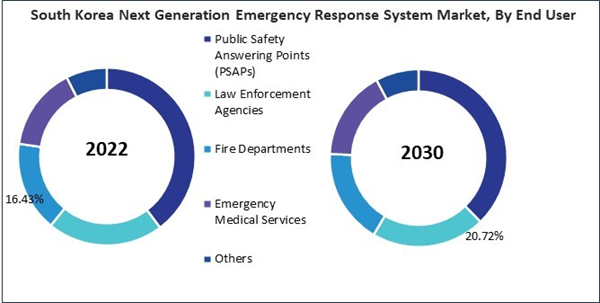The China market dominated the Asia Pacific Next Generation Emergency Response System Market by Country in 2022 and would continue to be a dominant market till 2030; thereby, achieving a market value of $286.2 million by 2030. The Japan market is registering a CAGR of 6.4% during (2023 - 2030). Additionally, The India market would showcase a CAGR of 7.7% during (2023 - 2030).
Next generation emergency response systems refer to advanced and innovative technologies, methodologies, and approaches designed to enhance the efficiency, effectiveness, and adaptability of emergency preparedness, response, and recovery efforts. These systems leverage advanced sensors, satellite imagery, and predictive analytics to detect and predict disasters and emergencies before they occur. Early warning systems enable authorities to issue timely alerts and notifications, allowing affected populations to take preventive measures and evacuate if necessary. Next generation emergency response systems leverage advanced technologies such as IoT sensors, satellite imagery, and predictive analytics to monitor and predict natural disasters, facilitate early warning systems, and coordinate response efforts.
Emergencies caused by human activities, such as industrial accidents, terrorist attacks, and civil unrest, require rapid and coordinated response measures. Next generation emergency response systems enable authorities to quickly assess the situation, communicate with affected populations, and deploy resources effectively to mitigate the impact of man-made crises. Additionally, outbreaks of infectious diseases, pandemics, and public health emergencies require robust emergency response systems to control the spread of disease, provide medical assistance, and ensure public safety.
Due to climate change and urbanization, China is experiencing a surge in the frequency and intensity of natural disasters such as typhoons, floods, earthquakes, and landslides. The high frequency and severity of natural disasters in China drive the demand for more advanced and effective emergency response systems. Hence, the region’s frequent natural disasters and rising urbanization propel the market’s growth.
Based on Offering, the market is segmented into Hardware, Software, and Services. Based on Hardware Type, the market is segmented into Switching & Routing Equipment, Call Handling Systems, Network Infrastructure Equipment, and Others. Based on Software Type, the market is segmented into Call Management Software, Location-Based Services Software, Text Messaging Software, Multimedia Support Software, and Others. Based on Services Type, the market is segmented into Professional Services, and Managed Services. Based on End User, the market is segmented into Public Safety Answering Points (PSAPs), Law Enforcement Agencies, Fire Departments, Emergency Medical Services, and Others. Based on countries, the market is segmented into China, Japan, India, South Korea, Singapore, Malaysia, and Rest of Asia Pacific.
List of Key Companies Profiled
- Cisco Systems, Inc.
- Atos Group
- Motorola Solutions, Inc.
- AT&T, Inc.
- Carbyne Ltd.
- Hexagon AB
- Everbridge, Inc.
- Esri, Inc.
- Avaya, Inc. (Avaya Holdings Corp.)
- Sinch AB
Market Report Segmentation
ByOffering
- Hardware
- Switching & Routing Equipment
- Call Handling Systems
- Network Infrastructure Equipment
- Others
- Software
- Call Management Software
- Location-Based Services Software
- Text Messaging Software
- Multimedia Support Software
- Others
- Services
- Professional Services
- Managed Services
- Public Safety Answering Points (PSAPs)
- Law Enforcement Agencies
- Fire Departments
- Emergency Medical Services
- Others
- China
- Japan
- India
- South Korea
- Singapore
- Malaysia
- Rest of Asia Pacific
Table of Contents
Companies Mentioned
- Cisco Systems, Inc.
- Atos Group
- Motorola Solutions, Inc.
- AT&T, Inc.
- Carbyne Ltd.
- Hexagon AB
- Everbridge, Inc.
- Esri, Inc.
- Avaya, Inc. (Avaya Holdings Corp.)
- Sinch AB
Methodology

LOADING...









